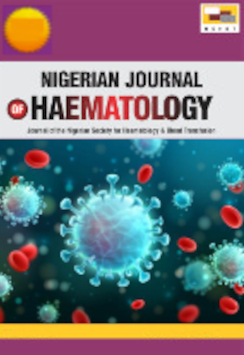Effect Of Hydroxyurea On Thrombospondin-1 And Soluble L-Selectin Levels Among Steady State Patients With Sickle Cell Anaemia
Keywords:
hydroxyurea, soluble L-selectin, thrombospondin-1, steady state, sickle cell anaemiaAbstract
Background: Sickle cell anaemia (SCA) is characterized by unpredictable episodes of vasoocclusion. Adhesion molecules, sickled red blood cells and inflammatory stimuli all contribute to these episodes. Hydroxyurea (HU) has proven to be effective in reducing the frequency of pain episodes in SCA, notably via an Hb F dependent mechanism.
Aims and Objectives: The objectives of this study are to determine the relationship between HU therapy and serum levels of thrombospondin-1 and soluble L-selectin in patients with SCA; and assessed the relationship between the use of HU and clinical severity of the disease.
Materials and Methods: Sixty (60) patients with SCA (30 HU exposed and 30 HU naïve patients respectively), all in steady state, were recruited. They were administered structured questionnaire. Clinical determinants and laboratory tests, which include full blood count, soluble L-selectin and thrombospondin-1 were assessed. Clinical severity scores were also computed. Appropriate statistical tools were utilised for data analysis.
Results: Patients with SCA exposed to HU had lower values of thrombospondin-1 and soluble Lselectin compared to HU naïve controls (P < 0.001; and P = 0.121 respectively). Most patients on HU had mild disease when compared to their HU naïve counterparts based on clinical severity score {29/30 (96.7%) vs 18/30 (60.0%), χ2 = 13.918; df = 2; P = 0.001}. There was a significant correlation between thrombospondin-1 levels and clinical severity score in both HU exposed and HU naïve patients with SCA (rho = 0.545; P < 0.001 and rho = 0.509; P = 0.002 respectively). Soluble Lselectin levels showed no significant correlation with clinical severity score in both groups (rho = 0.256; P = 0.086; and rho = 0.255; P = 0.173 respectively).
Conclusion: The usage of HU may significantly reduce levels of thrombospondin-1, but not those of soluble L-selectin in patients with SCA.
Downloads
References
John Hopkins Medicine Health Library. Sickle Cell Disease [Online]. Available from:http://m.hopkinsmedicine.org/healthlibrary/ conditions/hematology_and_blood_disorders/sic kle_cell_disease. [Accessed 16th August, 2019]
Manwani D, Frenette P. Vaso-occlusion in Sickle Cell Disease: Pathophysiology and novel targeted therapies. Blood 2013; 122(24):38923898.
Johnson C, Telen MJ. Adhesion molecules and hydroxyurea in the pathophysiology of sickle cell disease. Haematologica 2008; 93:481-485.
Agrawal R, Patel R, Shah V, Nainiwal L, Trivedi B. Hydroxyurea in Sickle Cell Disease: Drug Review. Indian J Haematol Blood Transfus. 2014; 30(2):91-96.
Bartlett J. Introduction to sample size calculation using G*Power [Online]. Available from: www.osf.io. Accessed 20th November, 2019.
Akinola N, Stevens S, Franklin I, Nash G, Stuart J. Subclinical ischemic episodes during the steady state of sickle cell anaemia. J Clin Pathol. 1992; 45:902-6.
Brown BA. Routine Haematology Procedure. In: Brown BA (ed). Hematology: Principles and Procedure. 5th ed. Philadelphia: Lea and Febiger; 1988. p. 79-116.
Okocha E, Onwubuya E, Osuji C, Ahaneku G, Okonkwo U, Ibeh N, et al. Disease Severity Scores and Haemogram Parameters in Nigerian Sickle Cell Disease Patients. J Blood Disord Transfus. 2015; 6(6):1-5.
Okocha E, Onwubuya E, Osuji C, Ahaneku G, Okonkwo U, Ibeh N. Serum Ferritin and Severity Scores in Sickle Cell Disease Patients in Nnewi (South East Nigeria). Br J Med Res. 2016; 11(2):1-7.
Hedo C, Aken’ova Y, Okpala I, Durojaiye A, Salimonu L. Acute phase reactants and severity of homozygous sickle cell disease. J Intern Med. 1993; 233:467-470.
Adzika V, Glozah F, Ayim-Aboagye D, Ahorlu C. Socio-demographic characteristics and psychosocial consequences of sickle cell disease: the case of patients in a public hospital in Ghana. J Heal Popul Nutr [Online]. 2017;36(4). Available from: https://jhpn.biomedcentral.com/articles/10.1186/ s41043-017-0081-5. [Accessed 13th September, 2019].
Cobo V, Chapadeiro C, Ribeiro J, MoraesSouza H, Martins R. Sexuality and sickle cell anaemia. Rev Bras Hematol Hemoter. 2013; 35(2):89-93.
Kyari G, Ayodele J. The socio-economic effect of early marriage in NorthWestern Nigeria. Meditteranean J Soc Sci. 2014; 5(14):582-92.
Italia K, Jain D, Gattani S. Hydroxyurea in sickle cell disease - a study of clinico-pharmacological efficacy in the Indian haplotype. Blood Cells Mol Dis. 2009; 42(1):25-31.
Silva-Pinto A, Angulo I, Brunetta D, Neves F, Bassi S, De Santis G. Clinical and haematological effects of hydroxyurea therapy in sickle cell patients: a single-center experience in Brazil. Sau Paulo Med J. 2013; 131(4):1-5.
Milligan C, Rees D, Ellory J, Gibson J. A nonelectrolyte haemolysis assay for diagnosis and prognosis of sickle cell disease. J Physiol [Online]. 2013;591(6). Available from: www.researchgate.net. [Accessed 25th September, 2019]
Lanzkron S, Strouse J, Wilson R. Systematic review: Hydroxyurea for the treatment of adults with sickle cell disease. Ann Intern Med. 2008; 148(12):939-955.
Quieroz A, Lobo C, Nascimento E, Pereira B, Bonini C, Cardoso G, et al. The mean corpuscular volume and hydroxyurea in Brazilian patients with sickle cell anaemia: A surrogate marker of compliance. J Blood Disord Transfus. 2013; 4(5):1-4.
Hesdorffer C, Longo D. Drug-Induced megaloblastic anaemia. N Engl J Med. 2015; 373:1649-58.
Patel D, Mashon R, Patel S, Das B, Purohit P, Bishwal S. Low dose hydroxyurea is effective in reducing the incidence of painful crisis and frequency of blood transfusion in sickle cell anaemia patients from Eastern India. Hemoglobin. 2012; 36(5):409-420.
Hillerey C, Du M, Wang W, Scott J. Hydroxyurea treatment decreases the in-vitro adhesion of sickle erythrocytes to thrombospondin and laminin. Br J Haematol. 2000; 109:322-327.
Styles L, Lubin B, Vichinsky E, Lawrence S, Hua M, Test S, et al. Decrease of very late activation antigen-4 and CD 36 on reticulocytes in sickle cell patients treated with hydroxyurea. Blood 1997; 89(17):2554-2559.
Odievre M, Bony V, Benkerrou M, Lapoumeroulie C, Alberti C, Ducrocq R, et al. Modulation of erythroid adhesion receptors expression by hydroxyurea in children with sickle cell disease. Haematologica. 2008; 93(4):502-511.
Isenberg J, Romeo M, Yu C, Yu C, Nghiem K, Monsale J, et al. Thrombospondin-1 stimulates platelet aggregation by blocking the antithrombotic activity of nitric oxide/cGMP signalling. Blood 2008; 111(2):613-623.
Saleh A, Hillen H, Duits A. Levels of endothelial, neutrophil and platelet-specific factors in sickle cell anaemia patients during hydroxyurea therapy. Acta Haematol. 1999; 102(1):31-37.
Benkerrou M, Delarche C, Brahimi L, Fay M, Vilmer E, Elion J, et al. Hydroxyurea corrects the dysregulated L-selectin expression and increased H2O2 production of polymorphonuclear neutrophils from patients with sickle cell anaemia. Blood. 2002; 99(7):2297-2302.
Aliyu ZY, Tumblin AR, Kato G. Current therapy of sickle cell disease. Haematologica. 2006; 91(1):7-10.
Novelli E, Kato G, Ragni M, Zhang Y, Hildesheim M, Nouraie M. Plasma thrombospondin-1 is increased during acute sickle cell vaso-occlusive events and associated with acute chest syndrome, HU therapy and lower haemolytic rates. Am J Haematol. 2012; 87(3):326-330.
Downloads
Published
Issue
Section
License
Copyright (c) 2023 Nigerian Journal of Haematology

This work is licensed under a Creative Commons Attribution-NonCommercial-NoDerivatives 4.0 International License.








